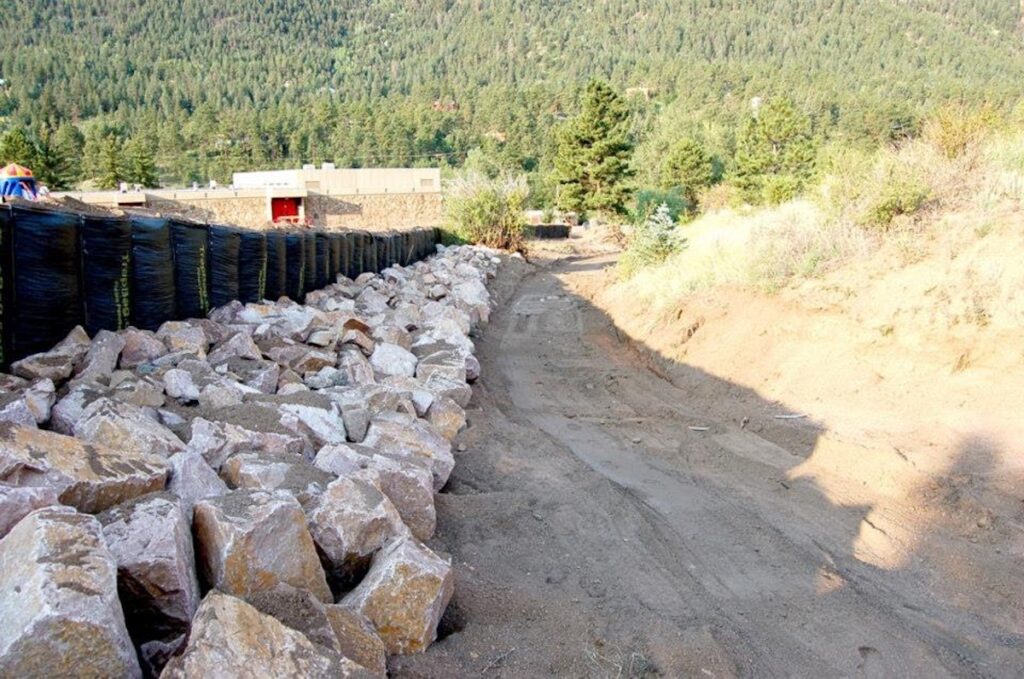How to Prevent Mudslides
Learn how to prevent mudslides effectively using TrapBags: durable flood barriers that redirect water flow and stabilize slopes.

Have you witnessed news coverage showing homes uprooted from their foundations, roads being washed away by walls of mud and debris, and communities facing severe risks when intense storms strike?
Mudslides and debris flows pose a serious risk to homes and infrastructure in areas with loose, saturated soil, especially after wildfires or heavy rain. Understanding how to prepare is critical to protecting your property, family, and community.
As local leaders, it’s critical that proactive steps are taken in order to protect residents against the increasing mudslide threat. We’ll look at how to prevent mudslides from resulting in property damage, injuries, and deaths when the ground gives way.
Read on to start formulating your mudslide prevention plan today.
What Causes Mudslides?
Mudslides occur when loose soil and sediment become saturated with water—usually after periods of heavy rain or snowmelt—causing them to flow downhill. The risk increases dramatically in areas recently affected by wildfires, where vegetation that once stabilized the soil has been burned away.
Heavy Rain
Excessive, unrelenting precipitation is the prime trigger that can mobilize a mudslide. When the ground becomes saturated beyond its capacity to absorb water, the soil quite literally liquefies into a fluid flow. Areas that experience intense downpours over a short period are at highest risk.
Deforestation
Healthy root systems from trees, shrubs, and ground cover act like nature’s rebar, binding soil together. But when forests are clear-cut on slopes, that stabilizing network gets ripped away, allowing the soil to detach and go sliding downhill in a deluge.
Loose Soil
Certain soil conditions predispose an area to mudslides. Granular soils like sand or gravel are more prone to losing their grip when saturated. Layers of permeable sediment between harder bedrock create slippery faults that can shift.
Sloped Areas
The steeper the slope, the more likely gravity will win once the soil is destabilized and starts its descent. Hillsides, cliffs, canyon edges, and mountain roads all face amplified mudslide threats as slopes increase.
What Are Debris Flows?
Debris flows are fast-moving landslides that include a mixture of water, mud, rocks, and even trees. Unlike traditional mudslides, debris flows are more powerful and can cause catastrophic damage within seconds. They often occur in steep terrain and narrow canyons.
Here’s how they differ:
| Mudslide | Debris Flow |
| More soil-focused | Includes rocks, trees, debris |
| Slower-moving | Extremely fast and destructive |
| Common on slopes | Common in canyons and valleys |
How to Prevent Mudslides and Landslides
Landslides occur when destabilizing forces cause sections of rock, mud, or other materials to slide down a slope. Heavy rainfall, rapid snowmelt, earthquakes, volcanic activity, and even human disturbances like traffic or construction can trigger these hazards. Here are a few ways on how to prevent mudslides and landslides.
Vegetation
Leveraging nature itself is one of the most cost-effective preventative measures against mudslides. Those lush forests, tenacious shrubs, and resilient ground cover blanketing slopes are more than just scenic greenery. Their dense, interweaving root systems lace together and reinforce the soil.
Erosion Control
For areas at elevated risk, we need to supplement Mother Nature with erosion control. That’s where slope reinforcements like retaining walls, erosion-resistant rip-rap coverings, and carefully graded terracing come in. These defenses add structural integrity to weakened surfaces and channels that are prone to giving way under saturation.
Drainage
Another key defensive line is getting smarter about drainage. Well-designed systems like culverts and diversion ditches give excessive rainfall and runoff a safe path away from vulnerable soil instead of allowing it to saturate and loosen slopes.
Retaining Walls
Terraced slopes and barriers can both blend with the landscaping of your property while also creating a strong barrier that can redirect flows.
Risk Assessment
Before implementing any protections, you need a comprehensive risk assessment and hazard mapping analysis. By evaluating topography, soil types, recent burn scars, and historic mudslide paths, you can identify the highest risk zones. Those clear-eyed assessments allow communities to make smart decisions like restricting development in areas most primed for slides.
Barriers
For existing homes, roads, and infrastructure that can’t be easily relocated from high-risk zones, deployable barriers are the answer. These reinforced walls create a physical dam to force mudflows around and away from critical areas that other prevention tactics may not fully safeguard.
Why Choose TrapBag®?
When the time comes to construct that last line of defense against oncoming mudslides, you can trust the engineering behind TrapBag® flood barriers. These sand-filled bags pack have served as an indispensable asset on the frontlines of disaster zones around the world.
TrapBag® barriers are specifically engineered for emergency and long-term slope protection. With rapid deployment, interlocking design, and the ability to be filled with local materials, TrapBags have been used by municipalities and homeowners across the country to mitigate landslide and debris flow risks.
TrapBag® benefits include:
- Ability to fill with sand, gravel, or native soil
- Withstands years of UV exposure
- Quickly deployable
- Requires 40-50% less fill than traditional sandbags
Order TrapBag Today
Don’t wait until after the next big storm. Our erosion and debris flow experts can help assess your site and recommend a customized TrapBag® solution. Contact us today to discuss your community’s risks and how TrapBag can provide proven protection against mudslides and landslides.
Meet the author
Get the Dirt Before the Flood Hits
Stay ahead of flooding, erosion, and disaster response challenges. The Dirt, TrapBag’s monthly newsletter, delivers field-tested tips, real-world case studies, and the latest in barrier technology straight to your inbox.

